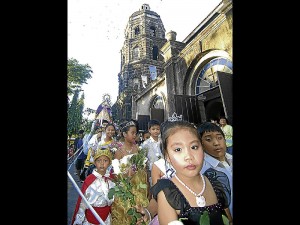
Angel costumes complete with cotton wings, or fancy gowns matched with tiaras and little heels, were the outfits of choice for little girls.
For the boys, it was the Barong Tagalog, though there was that restless kid who came in a cream top and pants with a red cummerbund, cape and crown too big for his newly shaven head.
It was the day of the Flores de Mayo, the culminating activity of month-long catechism classes where children had been taught various prayers and religious songs over the summer.
Held at the end of May and “since time immemorial” at the Sta. Ana church, says Parish Pastoral Council president Ernest M. Panis, the tradition that came to be known as Flores de Mayo was said to have originated in Malolos, Bulacan, in 1865.
It’s also often confused with another May event, the Santa Cruzan. While we now know it as the flamboyant parade of beauties clad in designer gowns and escorted by hunky gents, the real Santa Cruzan is a neighborhood procession where participants, dressed in characters of the Old Testament, pay homage to Empress Helena, mother of Constantine the Great, and the finding of the Holy Cross.
Extra special
“We’ve always been a Marian nation,” explains Panis of the Flores de Mayo’s relevance, “and we’d like to emulate Mary’s virtues and inculcate them in our young. This isn’t so much about the act of offering flowers. It’s about internalizing the qualities of the Blessed Virgin.”
Two things made this year’s Flores de Mayo at the Sta. Ana shrine extra special. For one, the fair weather allowed the kids to join a short procession around the neighborhood, something they hadn’t been able to do in previous years, “because it always rains,” says Panis.
This year’s Flores de Mayo also had a hermana mayor in the Society for Cultural Enrichment, Inc. (SCEI).
Chaired by Angola consul Helen Ong, the group was responsible for the flowers that adorned the altar, as well as the snacks for the kids post-procession, and the schoolbags presented to children who attended catechism classes regularly.
But the church has given the society much more in terms of exposure to a place steeped in history and art.
Established in 1725, the Shrine boasts a double balcony, higher-than-high ceilings, and an extravagant backdrop of saints’ statues surrounding the image of the Blessed Virgin Mary. The Virgin’s backside can be seen in the Camarin de la Virgen, a room on the second floor with a dramatic crown altar, authentic Ming Dynasty porcelain-tiled floors, and 16 well-preserved paintings of Jesus, the apostles, and the evangelists on its wooden ceiling.
What originally brought the SCEI to the Shrine, however, was the “pozo de la Virgen,” a well with miraculous powers akin to the healing waters of Lourdes in France. A wealthy businessman is said to pay regular visits to the well, as does a famous actress.
Sealed off by the Americans during a cholera epidemic, the poso, found in the side of the Shrine facing a Chinese temple, is undergoing restoration sponsored by the society.
Supporting the Flores de Mayo was but a natural next step for the group. “We decided to help preserve even the intangible heritage of the church,” says SCEI vice chair Dr. Jaime Laya.
Suddenly, a time-honored tradition for a community in Sta. Ana becomes a new one for a group eager to reconnect itself to our glorious past.